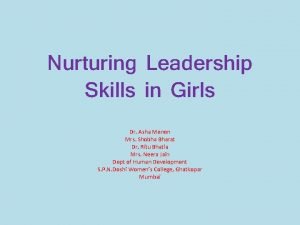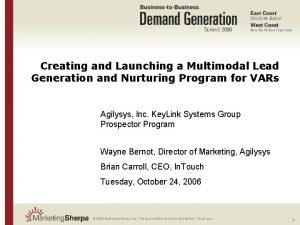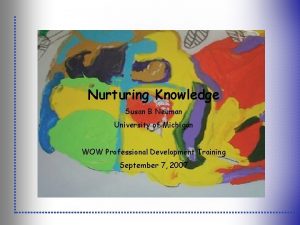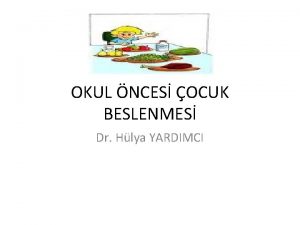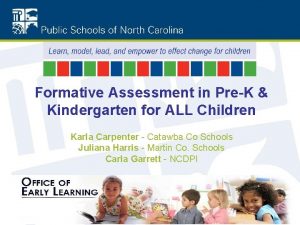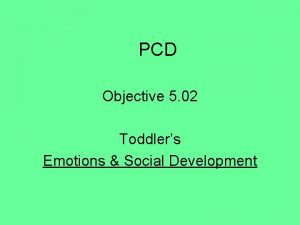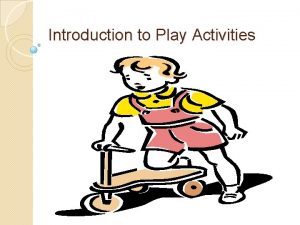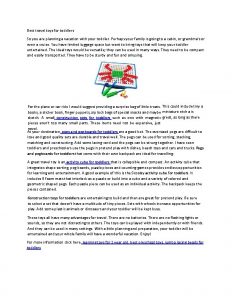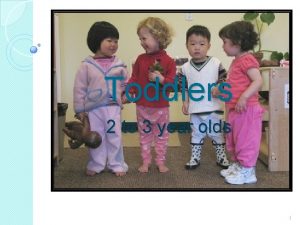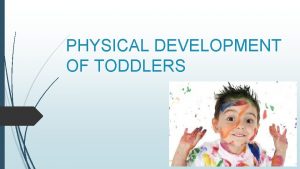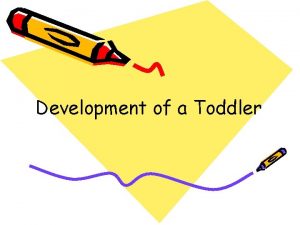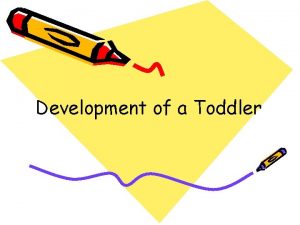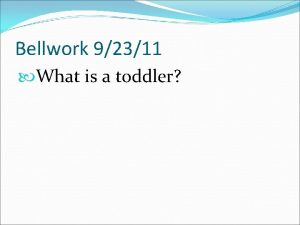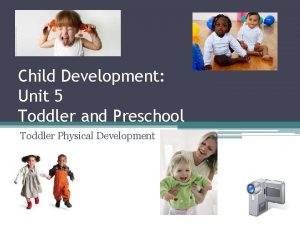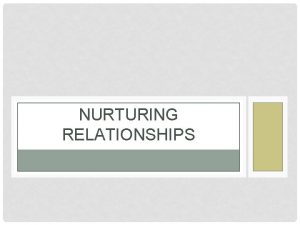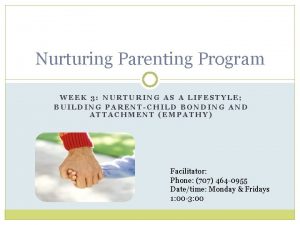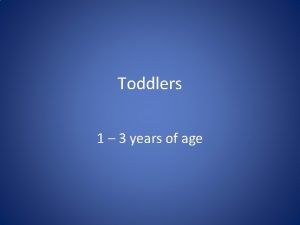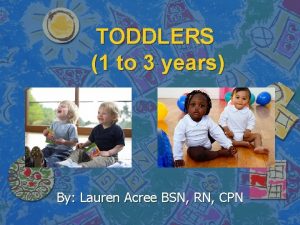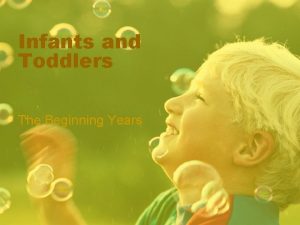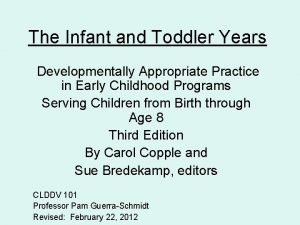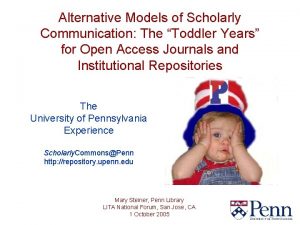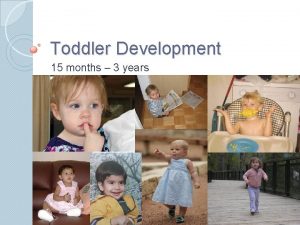Chapter 15 Nurturing Toddlers During the toddler years






















































- Slides: 54

Chapter 15: Nurturing Toddlers During the toddler years, children develop new skills that help them move toward independence. Child Care Today, Chapter 15: Nurturing Toddlers 1

Chapter 15: Nurturing Toddlers • toddler • autonomy • resort • self-help skills • solitary play • consistent • attention span • parallel play • symbolic thinking • receptive language • preoperational period • productive language • concept • separation anxiety • assimilation • accommodation • temper tantrum Child Care Today, Chapter 15: Nurturing Toddlers 2

Chapter 15: Nurturing Toddlers Development and Care No longer an infant, a child in the toddler stage is eager to absorb all the information she can as she gains independence. toddler A child between the ages of 12 and 36 months. Child Care Today, Chapter 15: Nurturing Toddlers 3

Chapter 15: Nurturing Toddlers Physical Development • Balance improves by 18 months. • Appetites decrease. • Teeth come in rapidly between 18 and 24 months. • Body proportions change. Child Care Today, Chapter 15: Nurturing Toddlers 4

Chapter 15: Nurturing Toddlers Physical Development Motor Development • Large- and small-motor development and coordination advance quickly. • Learning to walk means more independence. • Children begin to climb between 12 and 18 months. • Running, hopping, jumping, and pedaling skills improve. Child Care Today, Chapter 15: Nurturing Toddlers 5

Chapter 15: Nurturing Toddlers Average Heights and Weights of Toddlers Age Height Weight One Year 30 in. 22 lbs. Two Years 34 in. 28 lbs. Three Years 38 in. 32 lbs. Child Care Today, Chapter 15: Nurturing Toddlers 6

Chapter 15: Nurturing Toddlers Physical Development As children gain greater physical control, they develop self-help skills, such as getting dressed and using utensils. self-help skills Skills that allow children to help take care of their personal needs. Child Care Today, Chapter 15: Nurturing Toddlers 7

Chapter 15: Nurturing Toddlers Physical Development Self-Help Skills • Self-help skills help toddlers feel competent and proud. • Self-help skills include • getting dressed. • washing hands. • eating with utensils. • brushing teeth. • putting away toys. Child Care Today, Chapter 15: Nurturing Toddlers 8

Chapter 15: Nurturing Toddlers Physical Development Independent Toileting • Toddlers recognize the bodily sensations that precede elimination and understand the use and purpose of a toilet or a potty chair. • The learning process may take a few weeks or days. • Caregivers should treat accidents in a calm, matter-offact way. Child Care Today, Chapter 15: Nurturing Toddlers 9

Chapter 15: Nurturing Toddlers Intellectual Development Toddlers: • learn by doing and by using their senses. • continue to grow intellectually through sensorimotor development. • need freedom and time to explore a safe environment to satisfy their curiosity. • use trial and error, repetition, and imitation. Child Care Today, Chapter 15: Nurturing Toddlers 10

Chapter 15: Nurturing Toddlers Intellectual Development A child’s attention span increases as he gets older and gains more skills and experience. attention span The time spent focused on one activity. Child Care Today, Chapter 15: Nurturing Toddlers 11

Chapter 15: Nurturing Toddlers Intellectual Development Attention and Memory • Children tend to continue activities that are challenging, not boring or frustrating. • Interest in an activity and the activity’s developmental level can affect attention span. • Memory begins to develop in infancy and grows rapidly during the first two years. • Increased memory helps intellectual development. Child Care Today, Chapter 15: Nurturing Toddlers 12

Chapter 15: Nurturing Toddlers Intellectual Development Because toddlers are developing symbolic thinking, they enjoy make-believe play and playing dress up. symbolic thinking Understanding that one thing can stand for something else. Child Care Today, Chapter 15: Nurturing Toddlers 13

Chapter 15: Nurturing Toddlers Intellectual Development During the preoperational period, child care professionals can provide props such as boxes, blankets, or blocks to encourage imaginative play. preoperational period Piaget’s second period of intellectual development, between the ages of two and seven years, in which symbolic thinking occurs. Child Care Today, Chapter 15: Nurturing Toddlers 14

Chapter 15: Nurturing Toddlers Intellectual Development Symbolic Thinking • Children learn to use images, art, and language as symbols to represent objects, events, and concepts. • Between ages two and seven years, children start to think symbolically and imaginatively. • Imagination and creativity are natural products of symbolic thought. Child Care Today, Chapter 15: Nurturing Toddlers 15

Chapter 15: Nurturing Toddlers Intellectual Development Language Development • Vocabulary and language skills advance from ages one to three. • 18 -month-olds can respond “yes” or “no” to questions, identify body parts, and follow simple commands. • 2 - to 3 -year-olds know 50– 300 words and can follow more complex directions. Child Care Today, Chapter 15: Nurturing Toddlers 16

Chapter 15: Nurturing Toddlers Intellectual Development A child’s first concept may be that all dogs are called Max because that is the name of the family pet. concept A general idea formed from other information. Child Care Today, Chapter 15: Nurturing Toddlers 17

Chapter 15: Nurturing Toddlers Intellectual Development Piaget used the term assimilation to describe how children absorb and process information. assimilation Taking in new information and trying to make it fit with what is already known and understood. Child Care Today, Chapter 15: Nurturing Toddlers 18

Chapter 15: Nurturing Toddlers Intellectual Development Through accommodation, children alter their concepts to make better sense of new information. accommodation Changing one’s thinking to make new information fit. Child Care Today, Chapter 15: Nurturing Toddlers 19

Chapter 15: Nurturing Toddlers Intellectual Development Conceptual Development • The ability to understand concepts increases rapidly with emerging language skills. • Children use broad generalities when first labeling concepts. • Children absorb and make sense of information through assimilation and accommodation. Child Care Today, Chapter 15: Nurturing Toddlers 20

Chapter 15: Nurturing Toddlers Emotional Development As language improves, toddlers are less likely to resort to whining and crying to get what they want or need. resort To use or turn to somebody or something for help in dealing with a problem. Child Care Today, Chapter 15: Nurturing Toddlers 21

Chapter 15: Nurturing Toddlers Emotional Development • Toddlers are still beginning to develop emotional control and are prone to impulsiveness and mood swings. • Frustrations arise because toddlers’ abilities do not yet match their desire to learn and do more. • Language advances help children gain greater control over their behavior. Child Care Today, Chapter 15: Nurturing Toddlers 22

Chapter 15: Nurturing Toddlers Emotional Development Toddlers show their developing sense of autonomy when they see themselves as separate from their parents. autonomy Independence. Child Care Today, Chapter 15: Nurturing Toddlers 23

Chapter 15: Nurturing Toddlers Emotional Development Independence and Autonomy • Toddlers assert their independence and make their own decisions. • Toddlers often resist cooperating in routines. • Toddlers are sensitive about being shown, helped, or directed. Child Care Today, Chapter 15: Nurturing Toddlers 24

Chapter 15: Nurturing Toddlers Emotional Development Emerging Fears • Toddlers often fear storms, birds, and being alone. • Healthy fear contributes to children’s safety. • Fears can develop from: • lack of experience. • misconceptions. • other children. • adults. Child Care Today, Chapter 15: Nurturing Toddlers 25

Chapter 15: Nurturing Toddlers Emotional Development Emerging Fears When fears arise, • stay close to calm the child. • use simple language to explain the experience. • be patient. • talk about the child’s fears. • do not push children to overcome fears all at once. Child Care Today, Chapter 15: Nurturing Toddlers 26

Chapter 15: Nurturing Toddlers Emotional Development Importance of Security • A toddler’s sense of security is a primary emotional need. • Toddlers need reliable and predictable schedules. • Attachments to and secure relationships with specific people set the foundation for emotional and social development. Child Care Today, Chapter 15: Nurturing Toddlers 27

Chapter 15: Nurturing Toddlers Social Development • Social development progresses slowly for toddlers. • Toddlers are most at ease sharing time with a caregiver or two or three children. • Children develop stronger friendships after the age of three. Child Care Today, Chapter 15: Nurturing Toddlers 28

Chapter 15: Nurturing Toddlers Social Development From 18 to 24 months, children are curious about other children, but they engage mostly in solitary play Playing alone rather than with other children. Child Care Today, Chapter 15: Nurturing Toddlers 29

Chapter 15: Nurturing Toddlers Social Development Two toddlers who are investigating a toy at the same time are engaging in parallel play Children play near each other, but not with each other. Child Care Today, Chapter 15: Nurturing Toddlers 30

Chapter 15: Nurturing Toddlers Social Development Play and Social Development • Play is the best method of learning throughout the early childhood years. • From 18 to 24 months, children engage mostly in solitary play. • From 24 to 36 months, children engage in parallel play. Child Care Today, Chapter 15: Nurturing Toddlers 31

Chapter 15: Nurturing Toddlers Social Development Independence and Responsibility Caregivers can foster independence and responsibility by • promoting the use of self-help skills. • setting simple limits and rules. • modeling social skills. Child Care Today, Chapter 15: Nurturing Toddlers 32

Chapter 15: Nurturing Toddlers Nurturing Development Childhood educators should obtain information from parents about • extent of vocabulary and the primary language spoken at home. • small-motor, large-motor, and toilet skills. • napping habits. • typical behavior and recent experiences that might affect behavior. • experiences with other children. Child Care Today, Chapter 15: Nurturing Toddlers 33

Chapter 15: Nurturing Toddlers Nurturing Physical Development • Large-motor skill development activities include • push and pull toys. • wagons and wheeled toys. • opportunities to run, to jump, and to climb. • balls for kicking and tossing. • Small-motor skill development activities include • manipulatives. • art supplies. • sensory tables. • items with zippers, buttons, and snaps. Child Care Today, Chapter 15: Nurturing Toddlers 34

Chapter 15: Nurturing Toddlers Nurturing Intellectual Development Because toddlers learn best by using their senses, encourage intellectual development by using • matching games. • blocks. • nature experiences. • sensory experiences. Child Care Today, Chapter 15: Nurturing Toddlers 35

Chapter 15: Nurturing Toddlers Nurturing Intellectual Development Having receptive language means that toddlers understand much more language than they can speak. receptive language The ability to understand spoken words. Child Care Today, Chapter 15: Nurturing Toddlers 36

Chapter 15: Nurturing Toddlers Nurturing Intellectual Development Toddlers can understand many words, but they have a relatively low level of productive language The ability to use words to express oneself. Child Care Today, Chapter 15: Nurturing Toddlers 37

Chapter 15: Nurturing Toddlers Nurturing Intellectual Development Language Development • Toddlers have more receptive language than productive language. • Caregivers should use short and simple sentences, but not “baby talk. ” • Caregivers should encourage children in bilingual families to speak and practice words in both languages. Child Care Today, Chapter 15: Nurturing Toddlers 38

Chapter 15: Nurturing Toddlers Nurturing Emotional Development • Toddlers experience new feelings, fears, and struggles. • Caregivers should help toddlers deal with positive and negative emotions. • Building self-esteem optimizes emotional development. • Caregivers need to be warm, loving, and comforting. Child Care Today, Chapter 15: Nurturing Toddlers 39

Chapter 15: Nurturing Toddlers Nurturing Emotional Development Separation anxiety often occurs when a child transitions from the home to a child care facility. separation anxiety A child’s fear of separation from familiar people. Child Care Today, Chapter 15: Nurturing Toddlers 40

Chapter 15: Nurturing Toddlers Nurturing Emotional Development Separation Anxiety • Separation anxiety is a sign of positive emotional development. • It shows development of a strong emotional bond to parents or early educators. • Caregivers need to be patient and to help children cope. Child Care Today, Chapter 15: Nurturing Toddlers 41

Chapter 15: Nurturing Toddlers Nurturing Emotional Development Negativism • Negativism is a tendency to refuse to do something or to do the opposite of what is asked. • Negativism is a healthy sign of independence. • To reduce negativism, toddlers need chances to make choices and to practice self-help skills. Child Care Today, Chapter 15: Nurturing Toddlers 42

Chapter 15: Nurturing Toddlers Nurturing Emotional Development During a temper tantrum, a child may scream, kick, throw toys, or lash out in other hostile ways. temper tantrum An episode in which a child shows anger or frustration in an aggressive or destructive way. Child Care Today, Chapter 15: Nurturing Toddlers 43

Chapter 15: Nurturing Toddlers Nurturing Emotional Development Temper Tantrums • Toddlers do not yet have the coping skills to handle frustration. • A tantrum may occur when a want or a privilege is denied. • Offer age-appropriate activities so toddlers can experience success with minimal frustration. Child Care Today, Chapter 15: Nurturing Toddlers 44

Chapter 15: Nurturing Toddlers Nurturing Emotional Development Temper Tantrums If a tantrum occurs, • react calmly. • keep an eye on the child at all times. • provide a place to rest. • communicate with parents. Child Care Today, Chapter 15: Nurturing Toddlers 45

Chapter 15: Nurturing Toddlers Nurturing Social Development • Children begin cooperative play around age three. • Toddlers can understand simple rules for behavior. • Toddlers are just beginning to learn to share. • Disputes and conflicts occur among toddlers. • Caregivers encourage cooperation, set examples, take steps to minimize conflict, and maintain careful observation of the children. Child Care Today, Chapter 15: Nurturing Toddlers 46

Chapter 15: Nurturing Toddlers Managing Toddler Programs • Successful toddler programs work with parents to ensure that toddlers have the spaces and routines needed for development in all areas. • The leadership of the child care professional and collaborative teamwork by all care providers are essential to a program’s success. Child Care Today, Chapter 15: Nurturing Toddlers 47

Chapter 15: Nurturing Toddlers Classroom Spaces Toddler spaces require • age-appropriate furniture and toys. • a secure and comfortable environment. • learning centers appropriate for the age, size, and development of toddlers. Child Care Today, Chapter 15: Nurturing Toddlers 48

Chapter 15: Nurturing Toddlers Daily Routines Toddlers feel more secure when their routines, whether at home or in a child care setting, are consistent from day to day. consistent Continually the same. Child Care Today, Chapter 15: Nurturing Toddlers 49

Chapter 15: Nurturing Toddlers Daily Routines provide structure and a consistent schedule. A typical routine includes • arrival. • playtime in learning centers and outdoors. • diapering, toileting, and hand washing. • meals and snacks. • napping. • story time and music. • departure. Child Care Today, Chapter 15: Nurturing Toddlers 50

Chapter 15: Nurturing Toddlers Review Key Concepts Summarize the signs of physical, intellectual, emotional, and social development in toddlers. • Physical: learning to walk, decreased appetite, teeth come in, large- and small-motor skills improve, toileting begins. • Intellectual: learn by doing and using senses, attention span increases, memory improves, symbolic thinking occurs, language skills increase, concepts develop. • Emotional: mood shifts, autonomy increases, fears emerge. • Social: slow progress, solitary play followed by parallel play, independence and responsibility increase. Child Care Today, Chapter 15: Nurturing Toddlers 51

Chapter 15: Nurturing Toddlers Review Key Concepts Identify the information toddler programs need from parents to develop individualized care and activities. • extent of vocabulary and the primary language spoken at home • small-motor, large-motor, and toileting skills • napping habits • typical behavior and recent experiences that might affect behavior • experiences with other children Child Care Today, Chapter 15: Nurturing Toddlers 52

Chapter 15: Nurturing Toddlers Review Key Concepts Describe the key features of successful toddler programs. • Successful toddler programs work with parents to ensure that toddlers have the spaces and routines needed for development in all areas. • Toddler spaces need age-appropriate furniture and toys; a secure and comfortable environment; learning centers appropriate for the age, size, and development of toddlers; and a consistent daily routine. Child Care Today, Chapter 15: Nurturing Toddlers 53

End of Chapter 15 Nurturing Toddlers
 Nurturing leadership qualities
Nurturing leadership qualities Lead nurturing for charter schools
Lead nurturing for charter schools Lead nurturing reseller
Lead nurturing reseller Yvonne monaghan
Yvonne monaghan Nurturing school
Nurturing school Supplementary nurturing
Supplementary nurturing Nurturing knowledge
Nurturing knowledge Banajee list of toddler vocabulary
Banajee list of toddler vocabulary Peylonephritis
Peylonephritis Drdp preschool essential view
Drdp preschool essential view Toddler dönemi nedir
Toddler dönemi nedir Gillespie fracture
Gillespie fracture Infant/toddler sensory profile score sheet
Infant/toddler sensory profile score sheet Brigance infant and toddler screen
Brigance infant and toddler screen Fever in toddlers when to worry
Fever in toddlers when to worry Child observation samples
Child observation samples Goals of socialization
Goals of socialization Different types of play for toddlers
Different types of play for toddlers Creative curriculum intentional teaching cards
Creative curriculum intentional teaching cards Diagnostic stage of amoeba
Diagnostic stage of amoeba Milk for toddlers with milk allergynon dairy
Milk for toddlers with milk allergynon dairy Best travel toys for toddlers
Best travel toys for toddlers Kelsey carrio
Kelsey carrio Negativism in toddlers
Negativism in toddlers Sheep years to human years
Sheep years to human years 300 solar years to lunar years
300 solar years to lunar years Four score and seven years ago means
Four score and seven years ago means Hình ảnh bộ gõ cơ thể búng tay
Hình ảnh bộ gõ cơ thể búng tay Frameset trong html5
Frameset trong html5 Bổ thể
Bổ thể Tỉ lệ cơ thể trẻ em
Tỉ lệ cơ thể trẻ em Voi kéo gỗ như thế nào
Voi kéo gỗ như thế nào Tư thế worm breton
Tư thế worm breton Chúa yêu trần thế alleluia
Chúa yêu trần thế alleluia Các môn thể thao bắt đầu bằng từ đua
Các môn thể thao bắt đầu bằng từ đua Thế nào là hệ số cao nhất
Thế nào là hệ số cao nhất Các châu lục và đại dương trên thế giới
Các châu lục và đại dương trên thế giới Công thức tính thế năng
Công thức tính thế năng Trời xanh đây là của chúng ta thể thơ
Trời xanh đây là của chúng ta thể thơ Mật thư anh em như thể tay chân
Mật thư anh em như thể tay chân Làm thế nào để 102-1=99
Làm thế nào để 102-1=99 độ dài liên kết
độ dài liên kết Các châu lục và đại dương trên thế giới
Các châu lục và đại dương trên thế giới Thơ thất ngôn tứ tuyệt đường luật
Thơ thất ngôn tứ tuyệt đường luật Quá trình desamine hóa có thể tạo ra
Quá trình desamine hóa có thể tạo ra Một số thể thơ truyền thống
Một số thể thơ truyền thống Cái miệng bé xinh thế chỉ nói điều hay thôi
Cái miệng bé xinh thế chỉ nói điều hay thôi Vẽ hình chiếu vuông góc của vật thể sau
Vẽ hình chiếu vuông góc của vật thể sau Biện pháp chống mỏi cơ
Biện pháp chống mỏi cơ đặc điểm cơ thể của người tối cổ
đặc điểm cơ thể của người tối cổ Thế nào là giọng cùng tên
Thế nào là giọng cùng tên Vẽ hình chiếu đứng bằng cạnh của vật thể
Vẽ hình chiếu đứng bằng cạnh của vật thể Phối cảnh
Phối cảnh Thẻ vin
Thẻ vin đại từ thay thế
đại từ thay thế
